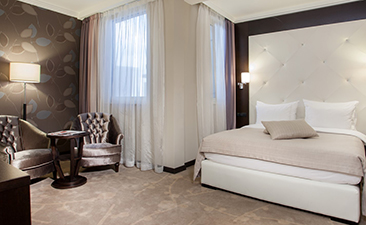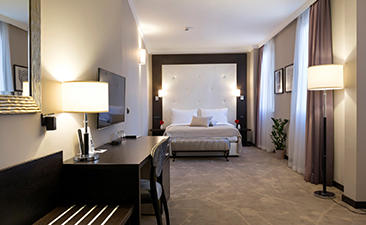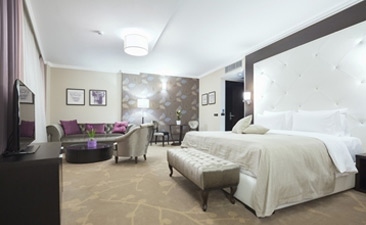Hotel Constantine the Great, 27. marta 12, 11000 Belgrade, Serbia, Tel : +381 11 4012 457

book now

book now
Hotel Constantine the Great, 27. marta 12, 11000 Belgrade, Serbia, Tel : +381 11 4012 457
 BUSINESS SINGLE ROOM
BUSINESS SINGLE ROOM
Business rooms (252) have been designed creatively with the needs of the modern traveler in mind.
Whether you are in need of good rest, refreshing shower or need your work area with 24/7 Wi-Fi access you will find this room was made for your great experience.
Read more CLASSIC DOUBLE ROOM
CLASSIC DOUBLE ROOM
Classic double room (302) is anything but classic.
Double bed in this spacious and well-designed room will fulfil your need for a good rest. Whether you are coming alone or in couple, classic double room can provide you with comfort and cosiness making your stay a unique experience.
Read more SUPERIOR DOUBLE ROOM
SUPERIOR DOUBLE ROOM
Superior room (382) will make you feel truly superior finding peace and relax after a long day.
Separated sitting area from sleeping space will make you more productive if you have unfinished business at the end of the day.
Read more LUXURY ROOM
LUXURY ROOM
Our large, luxury rooms (42-44m2) will make you feel at ease in a relaxed atmosphere when back from a day out.
Luxury rooms are designed and furnished with highest standards, capturing the Sun’s warmth most of the day will make sure you forget fast city pace and surrender to luxury.
Read more THE GREAT SUITE
THE GREAT SUITE
The Great suites will spoil you to bits. Find the stylish peace and perfect relaxation at our Great suites.
Spacious work area will ensure you get your business done. Enjoy a glass of wine in the lounge area of the suite while watching your favorite TV channels or spend a peaceful night.
Read moreNewsletter Signup
Sign up for our newsletter to receive updates and specials
stay updated
news, events and sightseeing2016/08/04
KalemegdanKalemegdan is the most beautiful and biggest park in Belgrade. At the same time it is the most important historical complex, in which the Belgrade Fortress is overlooking the confluence of the rivers Sava and Danube. Kalemegdan name refers to the wide plateau surrounding the Fortress, which has been in 19th century turned into a park. The planned development of Kalemegdan began 1890 when the military handed the park over to the Belgrade municipality. There are many monuments in the park, dedicated to the famous cultural and public workers. There is also the Kalemegdan Military Museum, Art Pavilion "Cvjeta Zuzoric," The Institute for Protection of Cultural Monuments, Zoo, children‘s amusement park, a large number of sports fields, restaurants and the Museum of Natural History.
read more
2016/08/03
St. Sava‘s TempleSt. Sava‘s Temple is a beautiful structure just behind Slavija square. It was built on the site which is thought to be the place where Sinan Pasha in 1595 burned the remains of Saint Sava, founder of the Serbian Orthodox Church. Although the interior is still far from finished, definitely take a walk around it as the entire plateau has now been reconstructed and makes for a great spot to enjoy a good book outdoors, or just recline in the sun.
read more
2016/08/02
SkadarlijaSkadarlija is a vintage street, an urban neighborhood and former municipality of Belgrade, the capital of Serbia. It is located in the Belgrade municipality of Stari Grad (Old town) and generally considered the main bohemian quarter of Belgrade, styled as the Belgrade Montmartre. Skadarlija began to acquire its bohemian character in the last few decades of the 19th century, and particularly after 1901,when the well-known Dardaneli inn was demolished and its guests, prominent writers and actors, moved to the Skadarlija inns or kafanas. The best-known of these were Tri šešira ("Three Hats"), Dva jelena ("Two Deer"), Zlatni bokal ("The Golden Chalice"), Bandist, East, Guild, Vuk Karadžić and The two Sergeants. The first three of these still survive today, accompanied by some new restaurants like Ima dana ("There will be days"), Skadarlija (demolished in 2006), Dva bela goluba ("Two White Doves"). The end section of Skadarlija is known as the Skadarlija atrium.
read more
2016/08/01
Old PalaceOld Palace was royal residence for the Obrenovic dynasty, while today is the Assebly of Belgrade. It is at the corner of Kralja Milana and Dragoslava Jovanovica Streets, across the New Palace. Palace, which was built by King Milan in the period 1881-1884, was the residence of King Petar I Karadjordjevic (period 1903-1921) and King Alexander I (1921-1922), and today it is the seat of the Belgrade City Assembly. In the spirit of academic and Renaissance decoration it was designed by Alexander Bulgarian. It‘s a very representative building, which originally embellished with two domes with golden crowns on top. However, since the Palace was badly damaged in World War II, today‘s appearance of the Palace is somewhat changed.
read more
2016/07/31
Gardoš towerThe major attraction is the Kula Sibinjanin Janka (The tower of Janos Hunyadi) or the Millennium tower, also known as the Tower on the hill or simply the Gardoš tower. It was built and officially opened on August 20, 1896 to celebrate a thousand years of Hungarian settlement in the Pannonian plain. It was part of the massive construction effort which included buildings in Budapest as well as four millennium towers on four directions of the world. Being the southernmost city in then Hungary within the Austria-Hungary, the tower was built on the ruins of the medieval fortress on Gardoš hill which barely survived today (only angular towers and parts of the defending wall). The tower was built as a combination of various styles, mostly influenced by the Roman elements. Being a natural lookout, it was used by Zemun‘s firemen for decades. Today, the tower is better known after the Janos Hunyadi, who actually died in the old fortress four and a half centuries before the tower was built.
read more
2016/07/30
Ada CiganlijaAda Ciganlija is a famous bathing area visited daily by thousands during summertime. Ada abounds in variety of daily contents: bike paths with rent-a-bike, tennis halls, golf courses, water skiing and a lot of other sport contents. It even contains a wedding park. Thanks to these attractions Ada gets visited by almost half of million of people daily. During the night you can have amazing time if you are a fan of urban sound and beautiful Serbian girls. Belgrade travel guide - Along the island there are dozens of cafes and clubs from which music can be heard at almost any part of the day and it makes your "hips swing". There are over 65 restaurants, caffes and clubs that are all around the lake as well as dozens of river clubs. There are many river houses, over a hundred that give you a special experience of Ada. At the very island is the "ada Safari", a smaller lake stocked with carp and other fish, regularly maintained for popular fishing competitions. Ada and its extensive offer make it one of the most visited Belgrade landmarks. Ada is one of the best places to relax especially during summer time.
read more
2016/07/29
Botanical gardenBotanical garden was founded in 1874 by the decree of the Ministry of Education of the Kingdom of Serbia, at the suggestion of Josif Pančić, famous botanist who also became its first manager. In 1889, king Milan Obrenović donated the estate (inherited from his grandfather Jevrem Obrenović) to the Great School in Belgrade for the purpose of the construction of botanical garden, provided that it be named "Jevremovac" (Serbian for "Jevrem‘s garden"), after his grandfather. It exists to this day at the same location and under the same name and gave its name to the small surrounding neighborhood. Apart from its founder, Josif Pančić, very important for the development and growth of Jevremovac was its longtime manager (1906-34), Nedeljko Košanin under whose supervision botanical garden lived its ‘golden age‘. Present manager (2011) is prof. Petar Marin. After World War II, new Communist authorities suppressed public usage of word Jevremovac, so it was simply known as "botanical garden" until 1990s when Jevremovac came into common usage again. Also, arboretum was very neglected for decades and only recently began its partial renovation and beautification but Jevremovac soon became popular again and today, with 60,000 visitors a year, it is the second most visited natural monument in Serbia, after the mountain and national park Kopaonik.
read more2016/07/28
Nikola Tesla MuseumNikola Tesla is often described as one of the most important scientists and inventors in the world‘s history, a man who "shed light over face of the Earth". He is best known for many revolutionary contributions in the field of electricity and magnetism in the late 19th and early 20th centuries.
Nikola Tesla Museum is one of a kind institution of science and culture in Serbia and the world, founded in 1952. It‘s the only museum in the world keeping original and personal inheritance of Nikola Tesla. Museum owns highly valuable collection consisting of more than 160,000 original documents, 2000 books and magazines, 1200 historical and technological exhibits, more than 1500 photographs, instruments and devices, 1000 plans and drawings. The special role of the museum is reflected in organizing, encouraging and promoting research in the field of history of science, in order to better recognize Tesla‘s contribution to the development of science and technology in the late 19th and early 20th century.
In 2016, Nikola Tesla Museum has presented a new, restored and digitized permanent exhibition in the museum - a digital exhibits based on VR technology, as well as technology of 3D mapping.
In the third room of the Museum, in the gold-plated sphere on the marble pedestal stands the urn with Tesla‘s ashes. After death Tesla was cremated and the urn was transferred to Belgrade in 1957.